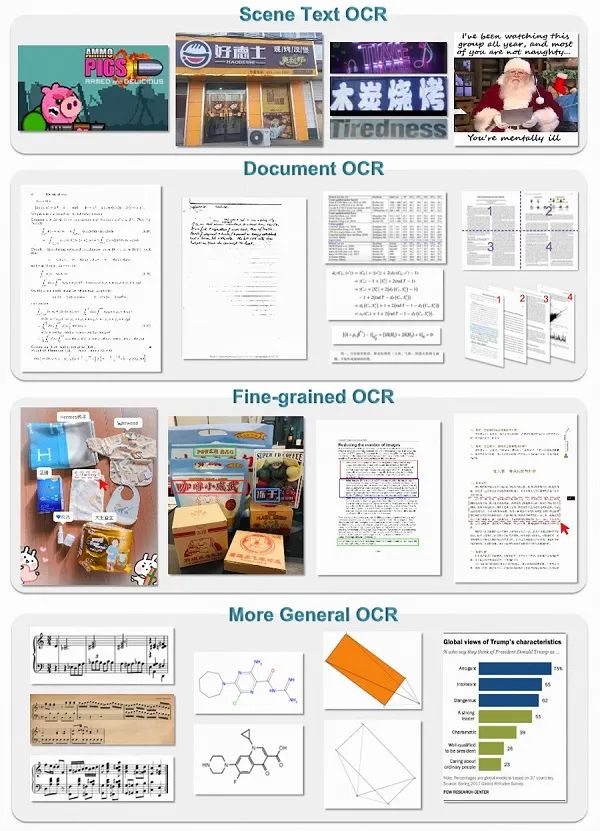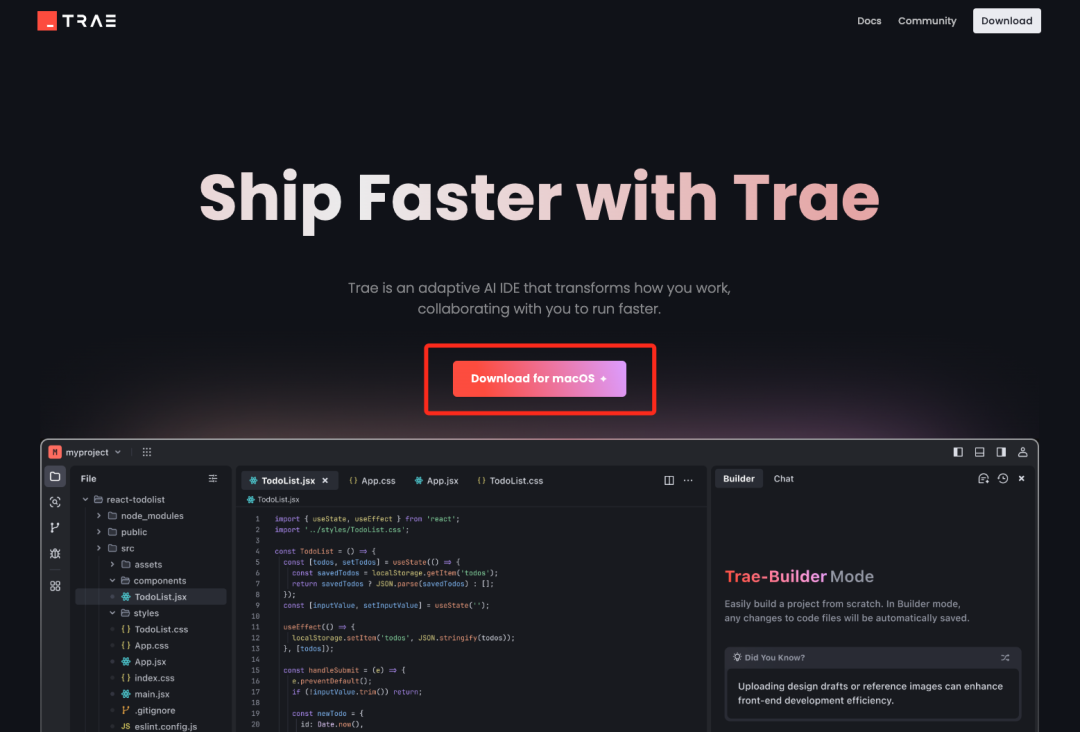OpenAI Releases "Free ChatGPT Course for Elementary and Middle School Teachers"
On November 20, 2024, OpenAI launched a free online course designed to help K-12 teachers bring ChatGPT to their teaching.
The course, titled ChatGPT Foundations for K-12 Educators byOpenAI partnered with non-profit organization Common Sense Media to develop the, for all educators and school districtsfree and openThe program, which has nine one-hour modules, covers AI basics and their use in education, "as well as ways to ensure student safety and privacy."

Image source: Common Sense
OpenAI says the course has been piloted in "dozens" of schools, including the Agua Fria School District in Arizona, the San Bernardino School District in California, and the charter school system Challenger Schools. according to OpenAI's internal research. 98% participants reported that the course provided new ideas or strategies that could be applied in the field.
"We are in the early stages of AI adoption in K-12 education, which will require educators, technologists, and organizations of all kinds to work together to ensure that this technology empowers teachers and improves student learning outcomes," said Leah Belsky, vice president and general manager of education at OpenAI (and former Coursera Chief Revenue Officer),"Our priority is to provide educators with resources to help them use OpenAI's tools judiciously and to set the standard for responsible use in the classroom.Developed in partnership with trusted organizations like Common Sense, this course provides an important foundation."
As a regular user of generative AI, and an occasional developer and scientist, I "finished" the course in about 20 minutes and got my certificate, but I'm not sure if I'll ever be able to get through it.For starters, this course is still worth a look. Considering the language of the course, I decided to reproduce the essence of the course in ChineseThe
I. Learning objectives
There are three learning objectives for this course:Understand what ChatGPT is and how it works; learn how to use ChatGPT to support your instructional practices; design best practices for applying responsible AI principles in a school settingThe
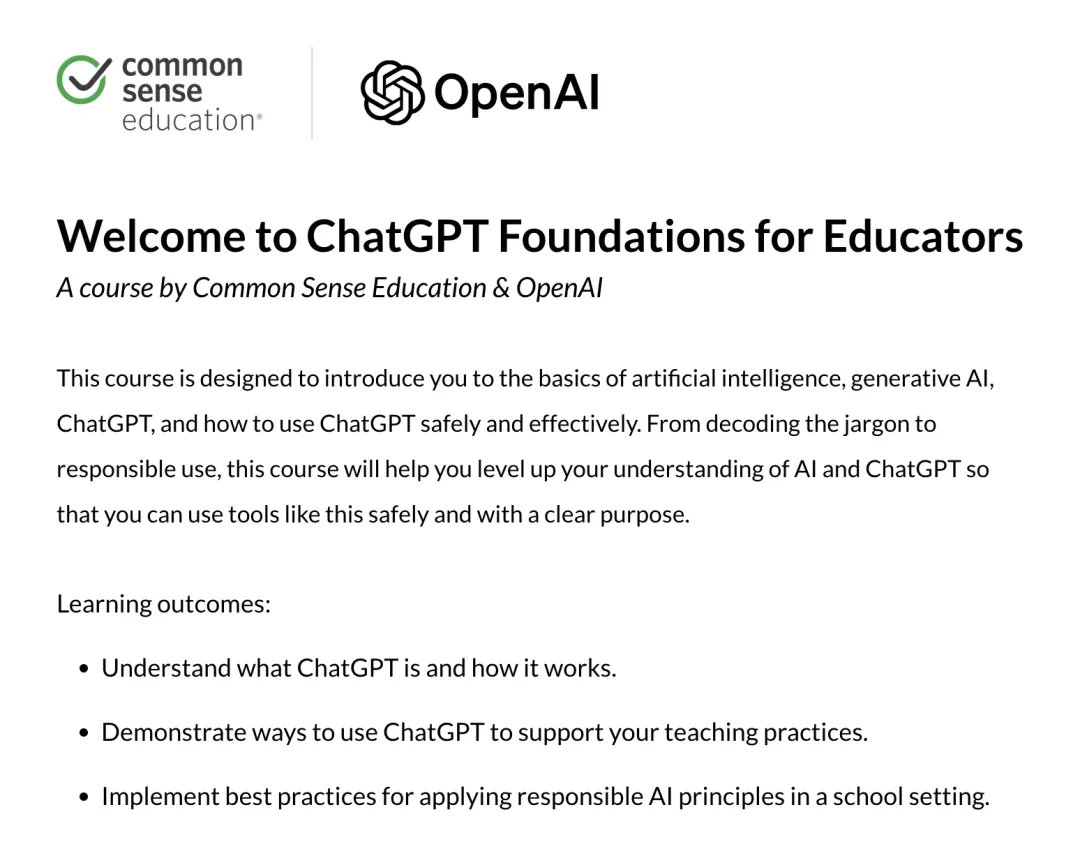
II. Main body of the course
(i) The first module of the course content is "What is ChatGPT and how does it work?"
While the concept of artificial intelligence may be new to you, the technology has been around for many years and is a vital part of our existing digital infrastructure.
Artificial intelligence can be seen as an assistive technology that can help humans navigate an increasingly complex world.
Artificial intelligence models learn by analyzing large data sets and recognizing patterns. The more data they process, the better they perform on tasks like predicting the weather or recommending movies.
ChatGPT is an artificial intelligence service from OpenAI. You can access it anywhere you have internet access. This tool puts the power of generative AI at your fingertips. You can use it to perform tasks that utilize generative AI, such as generating text and images. But it can do much more! ChatGPT can also help with tasks like translating text, analyzing data, and answering questions.
(ii) The second module of the course content is "Teaching and learning with ChatGPT".
Imagine you are talking to a coworker and need them to complete a task.To make sure they do exactly what you need them to do, you need to give clear, detailed instructions and provide ongoing guidance as they work.The same approach applies when using ChatGPT. The key to getting the best results is to provide specific, well-thought-out prompts and then refine the responses with further instructions.
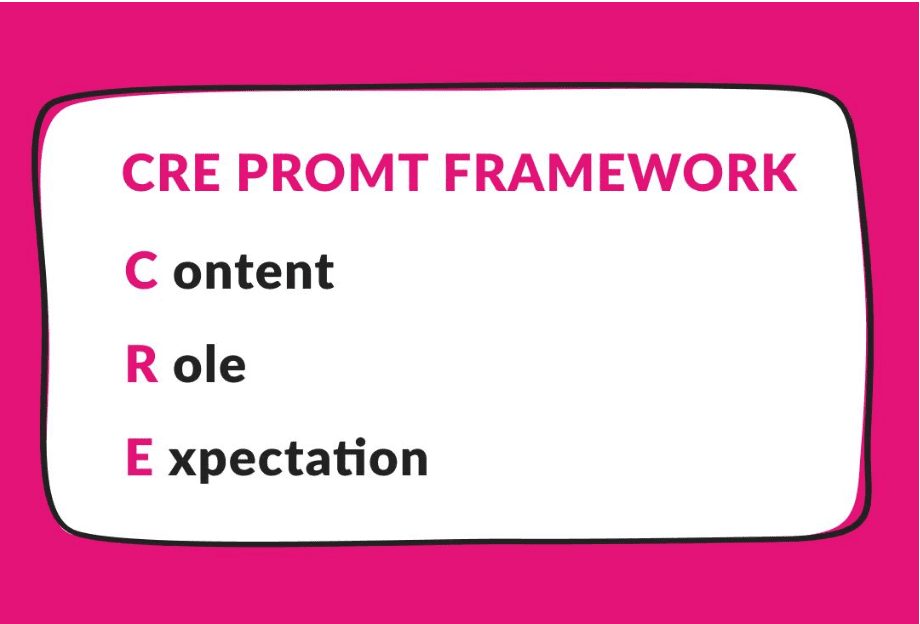
The CRE framework (Context, Role, Expectations framework) is a structured approach to building prompts for ChatGPT, ensuring that the AI clearly understands your request and provides the most relevant response.
(iii) The third module of the course content is "Using ChatGPT to improve productivity".
Imagine cutting your lesson plan time in half. What would you do with that extra time? Would it lead to more time interacting with your students? Maybe you could finally take a well-deserved break with your prep time.One of the easiest ways to increase your productivity is to first determine which administrative tasks can be automated through ChatGPTThe
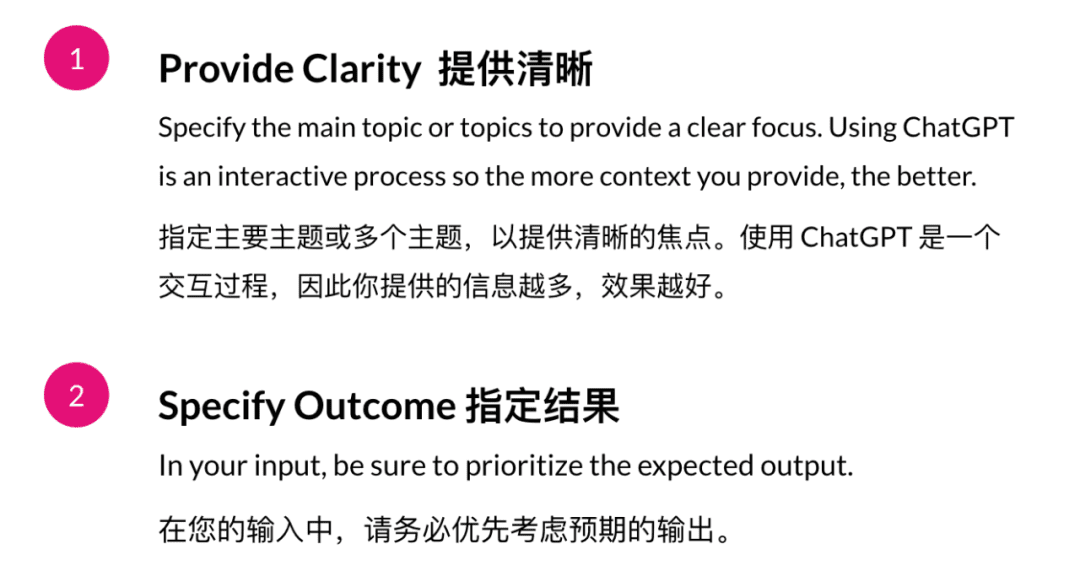
The course gives the following model cue words:
I am a 9th grade English teacher attending a department meeting. Our goal is to discuss [list specific topics]. Given the limited amount of time we have for our English department meeting, I want to make sure we achieve maximum efficiency. Can you suggest some strategies to keep the discussion focused and action-oriented while still allowing all other participants to comment?
(iv) The fourth module of the course content is "Using ChatGPT for lesson planning".
As a math teacher, you plan to adapt an upcoming unit to the needs of your students. In order to do this effectively, you need to review their test scores, math proficiency, and the qualitative feedback they share in class. You want to identify a list of questions to consider and blind spots to improve the next unit.
The course gives the following model cue words:
I am a math teacher seeking to improve my students' understanding of [specified math concept]. Based on their grades, test scores, and feedback [summarize key themes from student feedback], what three targeted goals can I set for the next unit to address their specific needs and misconceptions?
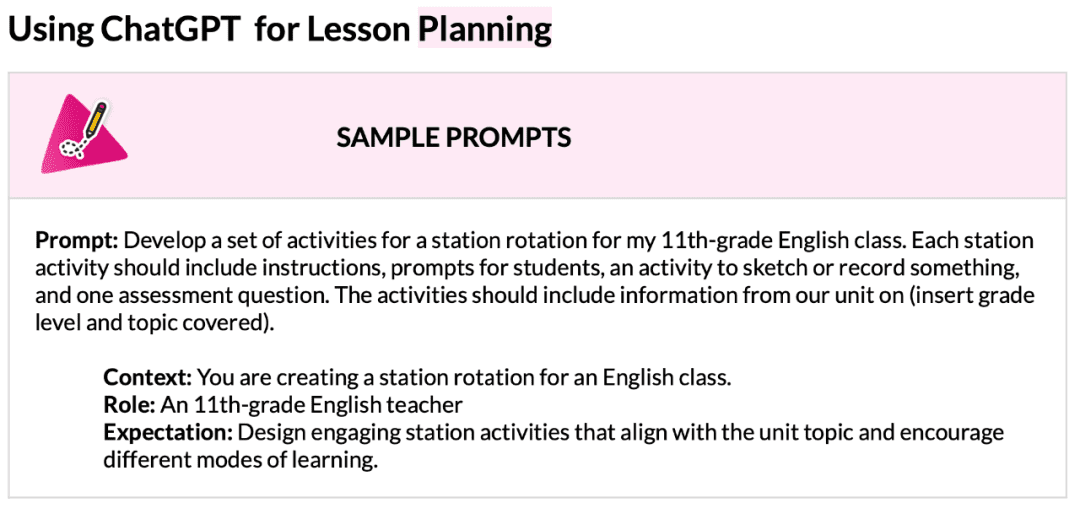
(v) The fifth module of the course content is "Using the Multimodal Functions of ChatGPT".
ChatGPT's prompts can include more than just input text.ChatGPT is a multimodal language model, which means that it can understand and respond to a wide variety of inputs and generate output in a variety of formats.
Think of multimodality as analogous to the way students learn through different senses-reading, looking at images, listening to audio, and even interacting with video.ChatGPT's multimodal capabilities work with all types of input, making it a versatile tool for creating content like the following:
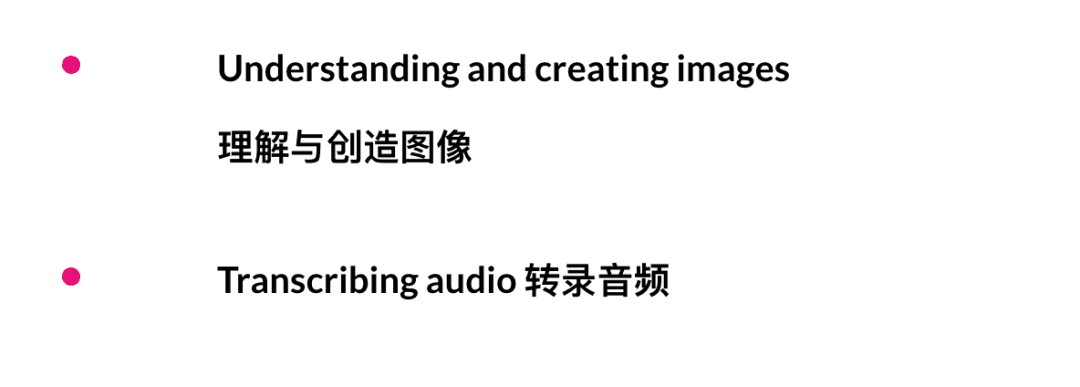
(vi) The sixth module of the course content is "Limitations of the use of ChatGPT and the status of teachers".
ChatGPT can be a powerful tool to support your teaching practice. As the tips above show, it can provide quick agendas for projects, generate ideas for assignments, and even provide explanations of complex topics. However, it is important to recognize its limitations:
OpenAI recognizes this in the course:Teachers can help students with hands-on practice, personalized instruction, emotional support, and instant feedback that ChatGPT can't do!
ChatGPT is not a substitute for your interactions with your students. You are in a much better position to provide the individualized attention and support your students need. While ChatGPT can be a valuable resource, it should be used in conjunction with your existing practices.
As with any technology, the safety and effectiveness of ChatGPT depends on how it is used. While ChatGPT is a powerful tool that can enhance efficiency and complement your work, it is not a substitute for your expertise.
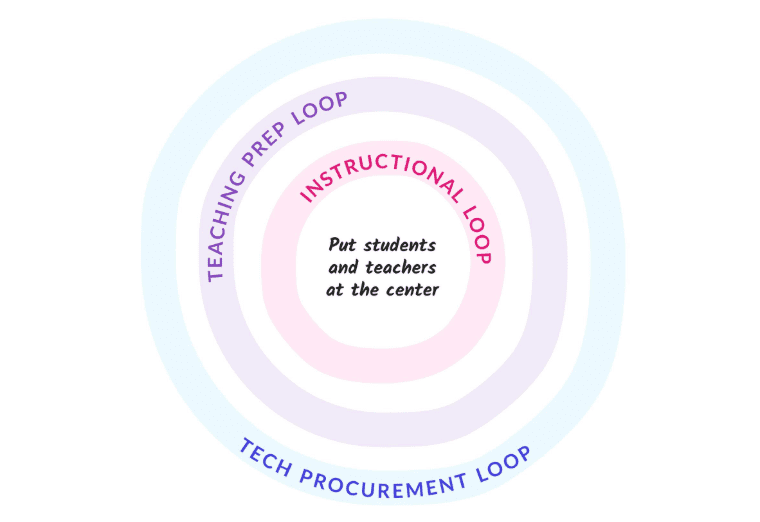
This image shows a model of an educational ecosystem that is "student and teacher centered". The model is organized into three cycles, from the inside out:
- Instructional Loop
- This is the core component that focuses on the direct interactive process of teaching and learning in the classroom, with the goal of placing the needs of students and teachers at the center and enhancing learning.
- Teaching Prep Loop
- This layer involves the preparation of instructional resources and professional development for teachers to support instructional activities in the classroom.
- Tech Procurement Loop
- The outermost level is concerned with the procurement and distribution of technical equipment and tools to provide the necessary support for teaching and preparation.
The model emphasizes a coordinated relationship between the three and focuses on "students and teachers" to ensure that technology, resources, and instructional design are closely aligned to serve real-world teaching and learning needs.
and proposed the principle of "human-in-the-loop".Putting humans at the center of AI decision-making is key to mitigating risks such as potential bias, privacy concerns, and harmful content creation. As an educator, it is your responsibility to critically evaluate when and how to utilize generative AI, always prioritizing student well-being and learning outcomes.
III. Evaluation of the course
As an introductory course, OpenAI systematically explains how to use ChatGPT in teaching, however, in my personal experience, there are some exaggerations, for example, ChatGPT's multimodal generation capability is only capable of AI drawing, and cannot easily realize the audio and video interactions in the course - - at least it requires OpenAI TTS and TTS. -At the very least, it requires OpenAI's TTS and Sora and other models work together, and the current ChatGPT doesn't make it easy to invoke these features. But as a free entry-level public course (with a certificate provided), it's definitely worth checking out.
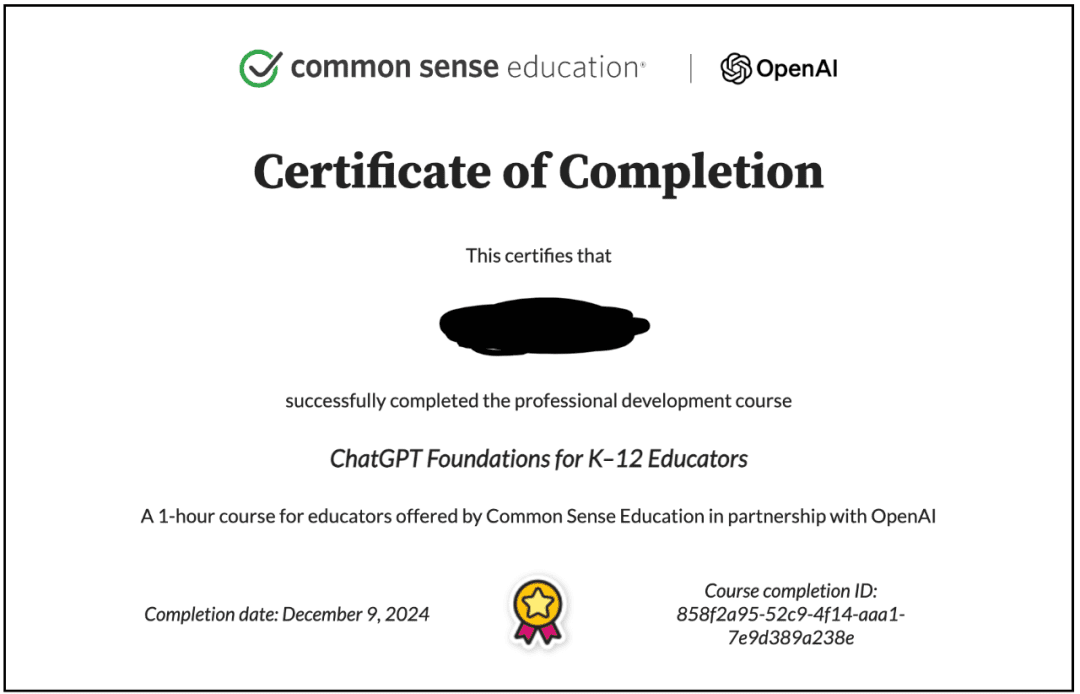
The comments of other experts were equally impressive.
Sin à Tes Souhaits, a visual artist and educator at the University of Arizona, finds AI tools useful in writing support materials such as homework guides.But he expressed concern about how OpenAI might control the content teachers generate using its services.
"If an educator creates a course using a platform and that company has the right to reuse and sell that data, that creates a lot of instability, and it's not clear to me how OpenAI would use, package, or sell content generated by its models."
Lance Warwick, a physical education lecturer at the University of Illinois at Urbana-Champaign, is concerned that resources like OpenAI may make educators who lack an understanding of the ethics of AI technology overly reliant on AI. he argues thatWhile the course covers some of the limitations of ChatGPT (e.g., the inability to score fairly), the modules on privacy and security are "very limited" and even contradictory.
As OpenAI writes in its guide.ChatGPT is not a substitute for interaction with students. Some educators and schools may never believe it can replace any part of the teaching and learning process.
© Copyright notes
Article copyright AI Sharing Circle All, please do not reproduce without permission.
Related posts

No comments...

